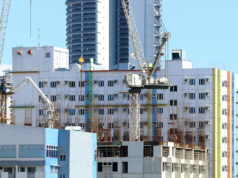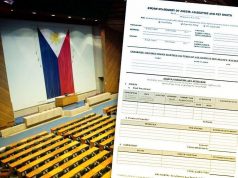Stand up for the Philippine Rise
On April 12, the Area Task Force (ATF) North under the National Task Force West Philippine Sea (NTF-WPS) will stage the ceremonial send off of the Philippine Rise Maritime Scientific Research team and buoy casting onboard BRP Tarlac at the Philippine Rise. The Philippine Rise is formerly known as Benham Rise.
In the 2012 United Nations decision, Benham Rise was confirmed as part of the Philippines’ continental shelf and territory. Five years later, Benham Rise was renamed as Philippine Rise by virtue of Executive Order (EO) No. 25. Changing the Name of “Benham Rise” to “Philippine Rise” and for other Purposes signed by President Rodrigo Duterte on May 16, 2017. Accordingly, all official maps and charts of the Philippines will use the name Philippine Rise to refer to the 13-million-hectare underwater plateau located near Aurora.
The BRP Tarlac was acquired in mid-2016 under the Armed Forces of the Philippines (AFP) Modernization Program during the administration of former president Benigno S. C. Aquino III. It is claimed to be the largest military sea vessel of the Navy — with a maximum carrying capacity of 11,583 tons capable of housing more than 600 personnel (crew and troops), and associated vehicles and equipment.
The ceremonial send off of marine researchers and buoy casting onboard the BRP Tarlac form part of recent Philippine government’s “efforts to establish maritime presence and situational awareness” in the country’s northeastern seaboard, an area which includes the Philippine Rise. Philippine Rise is located east of Luzon, and bigger than Luzon.
Isn’t this event timely and relevant? What can we gain from it? And to what extent can the National Task Force on the West Philippine Sea exercise and uphold its mandate?
SYMBOLIC YET POLITICAL ACT
The ceremonial send off of marine researchers and buoy casting onboard the BRP Tarlac on April 12 constitutes a symbolic and creative act of political will by the Philippine government. Ceremonial as it seems but it confirms our exclusive sovereign rights and jurisdiction in Philippine Rise. It is an act towards the right direction, that is, to keep and guard Philippine Rise as part of the country’s national territory. Moreover, it serves as a deterrent to other states to explore and exploit the area for interests without Philippines’ consent and other than maritime scientific research which is what the international law requires and demands.
The April 12 ceremonial event also constitutes a symbolic and creative act of resistance. It is resistance to China’s unwavering quest to control almost whole of the South China Sea. To date, China has refused to accept the award of the United Nations Convention on the Law of the Sea (UNCLOS) arbitral tribunal on Philippines’ jurisdiction over the West Philippine Sea.
In 2017, Chinese vessels were seen surveying the Philippine Rise. This has prompted the Philippine government to ask the Chinese Embassy in Manila to clarify the presence of a Chinese survey ship in the area. Beijing from its end, denied it and claimed that its Chinese vessels were exercising navigation freedoms and the right to innocent passage. But was it really the case? Philippine Defense Secretary Delfin Lorenzana himself had doubts as China’s claim contradicts its actions and innocent passage as codified in the UNCLOS.
In January 2018, Magdalo party-list representative Gary Alejano claimed that the Department of Foreign Affairs has granted the request of the Institute of Oceanology of Chinese Academy of Sciences (IO-CAS) for a maritime scientific research (MSR) in Philippine waters. The DFA has constantly reassured the Filipino publics that the approval and disapproval of any request for MSR in Philippine waters depends on whether the requesting party complies with our sovereign rights and jurisdiction.
But can this assurance assuage any apprehension and remove any doubts of the Filipino publics particularly if it is China which is the state party in question? Can it keep the Filipino publics’ confidence that its government is acting on the national interest and not hijacked by China’s interest? Is it in pursuit of the country’s independent foreign policy, or is it a ploy to mask some other interests at stake?
WHAT IS THERE TO GAIN?
On April 12, 2012, the UN Commission on the Limits of the Continental Shelf approved the Philippines undisputed claim to Benham Rise. The UN decision declared Benham Rise part of the Philippines’ extended continental shelf and territory. What the decision means is that the Philippines has the exclusive rights to develop resources in the area which, according to Professor Jay Batongbacal, is potentially a rich source of natural gas and other resources such as heavy metals. Two years thereafter, Filipino divers and marine resources experts and researchers dived into Philippine Rise for the very first time.
Under Article 246 of UNCLOS, the Philippines is obliged to allow foreign states to conduct marine scientific research (MSR) in its continental shelf like Philippine Rise. The purpose is “to increase scientific knowledge of the marine environment for the benefit of all mankind.” Nonetheless, only the Philippines has the exclusive sovereign right to explore and exploit the mineral resources in its extended continental shelf like Philippine Rise. Under the law, foreign states are obliged to seek for Philippines’ consent to conduct MSR and for purposes of maritime scientific research only.
Unlike Scarborough Shoal, Philippine Rise is not part of the disputed waters in the South China Sea. It is not part of China’s nine-dash-line claim, and no other state claims the area that is bigger than the province of Luzon. The sovereign exclusive rights and jurisdiction of the Philippines Rise in the area remain as it has always been prior to the UN award and will remain so pursuant to the UN decision in 2012. While all state parties are obliged to comply with the UN decision, the challenge is for the Philippine government to enforce and compel observance of the international law.
Isn’t it high time to seriously examine our present circumstances and redefine our rules of engagement? Shouldn’t we stand up for what is legally and historically ours? Taking it from Professor Jay Batongbacal’s recommendation, shouldn’t the Philippines enact a law or executive order that establishes the boundaries of its continental shelf? And from Supreme Court Senior Associate Justice Antonio Carpio, shouldn’t the Philippine government uphold the ruling of the UN?
The Philippine Rise or Benham Rise is ours! No less than President Duterte himself said so. If it is ours, then we must guard it and not allow China or any other state party to do whatever it wishes without our consent and against and beyond what is allowed and required by international law.
THE NATIONAL TASK FORCE ON THE WEST PHILIPPINE SEA
The National Task Force for the West Philippine Sea (NTF-WPS) was created on March 17, 2016 through Memorandum Circular 94 signed by former president Aquino after Filipino fishermen were harassed by the Chinese coast guard in the Scarborough Shoal or also known as Panatag Shoal or Bajo de Masinloc. Scarborough Shoal is an island group of 150 square kilometers located 124 nautical miles off the coast of Zambales province or west of Luzon. It is one of the oldest known fishing grounds of the Philippines.
The Chinese occupation of Scarborough Shoal in 2012 left the Philippine government with no other choice except to resort to file an international arbitration case against China. While the Permanent Court of Arbitration ruled in favor of the Philippines while defeating Beijing’s claim to a nine-dash-line territory, it did not rule on the sovereignty questions on Scarborough Shoal claiming that it is not within its jurisdiction.
The NTF-WPS is headed by the National Security Adviser with permanent representatives from different departments and agencies of the Philippine government as members, namely, the Departments of Foreign Affairs, National Defense, Justice, Interior and Local Government, Environment and Natural Resources, Energy, Agriculture, Trade and Industry, Transportation and Communications, and Finance, the National Economic Development Authority, National Coast Watch System, Armed Forces of the Philippines, Philippine National Police-Maritime Group Philippine Coast Guard, and the Bureau of Fisheries and Aquatic Resources.
Functions of the NTF-WPS provides that the NTF-WPS gets guidance from the president, through the Cabinet Cluster on Security, Justice and Peace, and is responsible “in orchestrating and synchronizing the employment of the different national government agencies’ capabilities to achieve the national objectives in the WPS and in submitting such reports and/or recommendations to the president through the Security Cluster.” It also provides that the NTF-WPS performs what used to be the functions of the Inter-Agency Coordinating Committee on the WPS.
The creation of the Area Task Force (ATF) North is provided in Section 3.
Based on Section 3 of Memorandum Circular 94, the ATF is in charge of orchestrating and synchronizing the efforts of the different government agencies at the area level and receives guidance and direction from the NTF-WPS.
Given their mandate, the NTF-WPS and ATF remain as policy coordinating entities at different levels.
Depending on the president’s order, however, these bodies can produce a better outcome while exercising their mandate. Our ATF-North is able and capable, and with a strong and defined order from the president, it can definitely do much more. When it happens, the symbolic/ ceremonial act indeed becomes a truly political act!
Diana J. Mendoza, PhD, is the Chair of the Department of Political Science at the Ateneo de Manila University.



